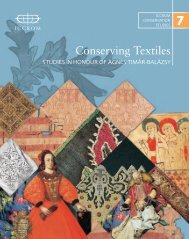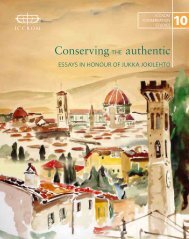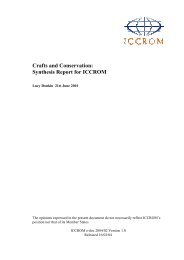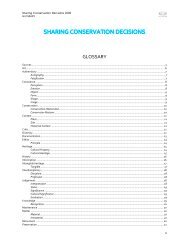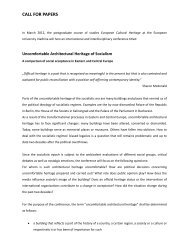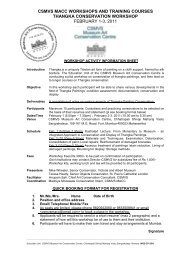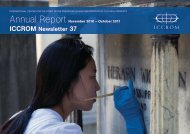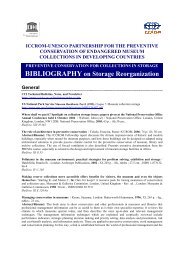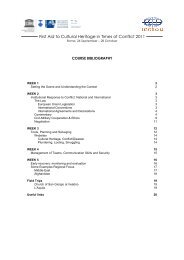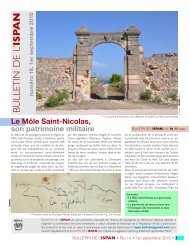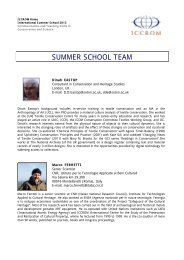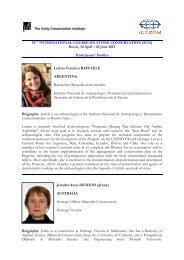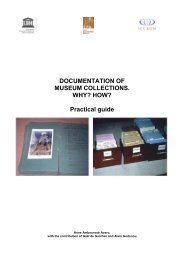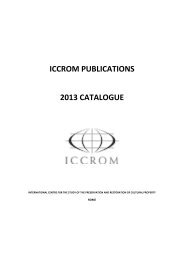part 1 - Iccrom
part 1 - Iccrom
part 1 - Iccrom
You also want an ePaper? Increase the reach of your titles
YUMPU automatically turns print PDFs into web optimized ePapers that Google loves.
Measuring Heritage Conservation Performance:<br />
the seminar<br />
Introduction<br />
One of the great challenges for institutions and scholars of heritage conservation and protection<br />
has been to develop instruments for assessing the performance of the conservation actions of complex<br />
assets such as urban sites, cultural territories, landscapes and collections of many types of<br />
objects. UNESCO, for example, has been improving its Periodic Reports on the state of conservation<br />
of the assets on the World Heritage List in order to make the evaluations more transparent and less<br />
subject to distortions caused by technical and political constraints. However, monitoring and evaluation<br />
systems remain at an incipient stage; such systems would allow the performance of conservation<br />
actions and their impacts to be identified, recorded and assessed in an objective way. There<br />
are few conservation monitoring systems in continuous use and they are generally concentrated in<br />
developed countries with well-established heritage conservation institutional structures. Costs are<br />
generally used as an excuse for not implementing the monitoring systems, but also transparency is<br />
not a usual practice in heritage policies around the world.<br />
There are some other difficulties encountered in designing and implementing heritage monitoring<br />
systems linked with the state of art of the conservation theory and practice. Ever since the Burra<br />
Charter, the theory of conservation has been undergoing a paradigm shift that sets the maintenance<br />
of significance as the central goal of heritage conservation. In addition to being informed by expert<br />
opinion, this change indicates that conservation of complex heritage assets must take into account<br />
the opinions of social actors directly involved with the assets (the stakeholders), and by doing so,<br />
this introduces cultural relativism and the use of subjectivity as an analytical tool. It is well established<br />
in theory that the assessment of the state of conservation of cultural assets is not objective in<br />
the positive sense. It depends on the subject that performs the evaluation and the criteria used to<br />
define damage or risks to the attributes of objects that convey values. This recognition does not put<br />
aside the objective methods for evaluating conservation, but frames them in a contingent structure.<br />
In this way, the use of indicators has been suggested as a useful way to construct a monitoring<br />
instrument applicable to the different types of complex assets as this permits the performance of<br />
conservation actions to be evaluated, as well as the associated public policies relating to conservation<br />
including the enhancement of economic value, sustainability and social inclusion.<br />
The 6 th International Seminar on Urban Conservation Measuring Heritage Conservation Performance<br />
addressed these issues by analysing both the theory and practice of evaluation of heritage conservation<br />
maintenance and of its impacts, and tried to respond to the following issues:<br />
1) What are the consequences of change in the theoretical paradigm for monitoring and evaluation<br />
instruments for complex assets such as urban sites, cultural territories, landscapes and<br />
collections of various objects?<br />
2) How can the performance of the conservation of heritage assets be evaluated over time? Can the<br />
performance of actions on different assets of the same kind or of different kinds be compared?<br />
3) What lessons are to be learned from the use of indicators in the evaluation of conservation<br />
actions? Is it possible to estimate the efficiency and effectiveness of using these instruments for<br />
monitoring heritage conservation?<br />
4) Have there been experiences of assessment or of use of conservation indicators that can contribute<br />
to the debate and so to the development of the theory and of the monitoring tools?<br />
v



